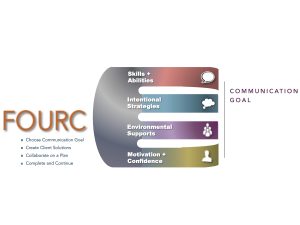FOURC Model
The FOURC model outlines a collaborative process for working with clients to identify and pursue self-identified goals, coordinate interventions, and achieve real life outcomes.
Four Steps
Four Prongs
|
 |
References:Haley KL, de Riesthal M, Barry J, & Cunningham K. (2019). Setting goals for communicative life participation in aphasia. American Journal of Speech-Language Pathology, 28 (1), 1-13. Cunningham K & Haley KL. (2018, November). Take back the wheel: a case study on integrated intervention for severe aphasia. Poster presented at: American Speech-Language Hearing Association Annual Convention. Boston, MA. Haley KL, Benitez C, Dwyer T, & Cunningham K. (2018, May). Aphasia intervention goals used by practicing speech-language pathologists. Paper presented at: Clinical Aphasiology Conference. Austin, TX. Haley KL, & Cunningham K. (2017, November). Aphasia Therapy by the Bootstraps: Harnessing Client-Driven Goals for Functional Intervention. Seminar presented at: American Speech-Language Hearing Association Annual Convention. Los Angeles, CA. Haley KL, Richardson J, & Jacks A. (2017, March). Preparing for clinical excellence: A practical framework to guide the journey. Poster presented at: Aphasia Access Leadership Summit. Orlando, FL. Haley KL, Richardson J, Jacks A, & de Riesthal M. (2015, November). Setting goals for communicative life participation in aphasia. Seminar presented at: American Speech-Language Hearing Association Annual Convention. Denver, CO.
|
|